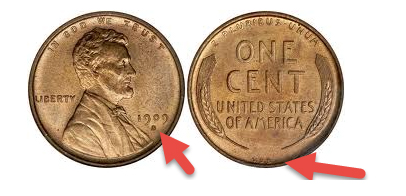
Guide to Lincoln Wheat Pennies
Wheat pennies also known as early Lincoln pennies are one of the most popular U.S. coins that many coin collectors look to build complete sets. With a few rare coins in the series such as the 1909-S VDB and 1914-D are known as the “Holy Grail” of the Lincoln Wheat penny or Lincoln cent collection. Before you go down the path of building a full set of Lincoln wheat pennies you should use the following as a guide to give you an approximate value and price of your Lincoln Wheat pennies.
History of the Lincoln Wheat Penny
The United States Mint minted the Lincoln Wheat Penny or “wheatie” as they are sometimes also name, in 1909. Creator Victor D. Brenner designed the coin under the direction of then President Theodore Roosevelt who was on a personal mission to redesign our nation’s US coinage. Lincoln was chosen as a subject for the penny to commemorate the 100th anniversary of his birth. What a President Lincoln was, he deserved to be on the most common of all currencies.
Initially in the first year Brenner’s three initials V.D.B. were placed on the reverse of the coin at the bottom between the stalks of the wheat stalks. This new design approach was a break from tradition where only the designer’s initial from his last name was used on the coin. However, then Mint Engraver Charles E. Barber strongly objected to the use of three initials on the coin. The reverse dies were remade, and all the initials were removed but not before some coins were already minted and released to the public. This extremely small release of coins resulted in what is now known as the exceedingly scarce 1909-S VDB Lincoln’s penny.
The Market for Lincoln Wheat Pennies
With the four different reverses on the modern Lincoln Cent in 2009 and the new Shield reverse that started in 2010, interest in Lincoln cents peaked for a few years. Although market prices have slowly eased over the last few years, this renewed interested has kept values and prices up.
Any wheat penny is worth at least 3-5 cents to most dealers. Given the popularity of collecting Lincoln Wheat cents, there will always be a demand for quality coins.
Key Dates and Rarities
The following Lincoln wheat cents in any condition, are worth considerably more than the other common wheat pennies. BEWARE: these coins are frequently counterfeit or altered from common wheat pennies. Such as after mint stamps like adding an S, or VDB. Therefore, before you start celebrating your new wealth with your new found fortune, have the coin authenticated by a PCGS or NGC reputable grading services. Many collectors do not consider their coin collection complete without the key sate Lincoln cents.
KEY DATES:
- 1909-S VDB (small “S” below the date and “V.D.B.” on the back at the bottom between the stems of the wheat ears) AKA “The Key”
- 1909-S, nice penny just missing the VDB, thus not as rare
- 1909-S Over Horizontal S (re-punched mintmark or RPM)
- 1914-D, collectors love this one
- 1917 Doubled Die Obverse
- 1922 No “D” ( Missing mint mark below the date)
- 1931-S
- 1943 Bronze/copper (cents in 1943 were made out of zinc plated steel, not copper) thus the few which slipped by with the previous year’s planchets are worth six figures. The most valuable of all!
- 1943-D Bronze/copper (cents in 1943 were made out of zinc plated steel, not copper) same as above, huge find if you have one…
- 1943 Copper/Bronze Penny (cents in 1943 were made out of zinc plated steel, not copper) same as above, this one is worth a condo in Florida…
- 1944 Steel Penny (cents in 1944 were again made out of copper/bronze, some old steel blanks got minted in 1944 by mistake) a few 1944 pennies were made from the previous years left overs, very valuable, just not as much as the 43 copper pennies
- 1944-D/D Over S Double Die, means the lettering/strike was doubled, thus you get a letter or date over each other, this is a great coin to find with strong examples worth thousands
- 1955/55 (doubled die) variety similar to above
Condition or Grade
If your coin is worn, it is considered a circulated coin. Intermediate and advanced coin collectors will learn how to grade using the Coin Grading Scale Sheldon scale of 1 to 70.
Mint Marks
The mint mark on the Lincoln Wheat Penny is located on the front/obverse of the coin, just below the date. Lincoln wheat pennies were produced at three different mints: Philadelphia (no mint mark), Denver (D) and San Francisco (S).
Lincoln Wheat Penny Value Chart
Buy Price (retail price) is what you can expect to pay to a dealer when you purchase the coin and Bid or sell price (wholesale) is what you can presume a coin dealer to pay you when you sell the coin. These are approximate retail and wholesale prices. The actual offer you receive from a particular coin dealer will vary depending on the actual grade of the coin and a number of other factors like condition rarity. Here is a link to the NGC retail Price guide for Wheat Pennies: https://www.ngccoin.com/price-guide/united-states/cents/99/


